A Guide To Jeonju Hanok Village: From Free Tours To Choco Pies
Last Updated on October 2, 2023
There are many fantastic places to visit in South Korea, but only one is the birthplace of bibimbap. Jeonju is a popular daytrip or weekend away for many in Korea thanks to it being a foodie lovers destination and of course featuring the beautiful Jeonju Hanok Village. Actually, Jeonju is one of the most popular destinations for travelers in Korea outside of Seoul.
Want to plan a trip to Jeonju Hanok Village? Check out the scenery? Eat some delicious bibimbap and chocolate treats or even visit a unique Hanok village? Here’s everything you need to know to plan a trip to Jeonju Hanok Village in Jeollabuk-do, Korea.

Plan a trip to Jeonju Hanok Village:
- How To Get There
- The History of Jeonju Hanok Village
- Where To Stay
- What To Do
- What To See
- What To Eat
- Bibimbap (비빔밥)
- Recommended places to go:
- Choco Pie (초코파이)
- Recommended places to go:
- Bibimbap (비빔밥)
- What To See Nearby
(This post contains affiliate links, which means I receive a certain percentage of a sale if you purchase after clicking at no cost to you. Thank you for your support.)
Jeonju Itinerary
How To Get There
Address: 99 Girin-daero, Pungnamdong 3(sam)-ga, Wansan-gu, Jeonju-si, Jeollabuk-do (전라북도 전주시 완산구 기린대로 99 풍남동3가)
By Train: The fastest and most convenient way to get to the Jeonju Hanok Village is via the train. From Yongsan Station, there’s a direct train you can take through the KTX terminal. You can buy tickets there as well and head down to the train tracks to await your trip. It’s around 2 hours to get there so sit back and relax for the ride. The prices range from W30,000 ~ to W60,000 depending on if you want a coach or first class seat. Once you arrive in Jeonju, hail a cab to get to the Hanok village. If you plan to travel quite a bit in Korea, definitely look into getting the Korea Rail Pass to save money and see it all!
By Bus: If you want an alternative, there is also a bus option which takes about 4 hours. It’s cheaper and the bus station in Jeonju is a bit closer to the Hanok village though you’ll still need a taxi to get there when you arrive. You can usually get right on a bus at the bus station, but if you want to ensure you can get on a bus at a certain time and have a ticket for sure, then pre-book your bus ticket to Jeonju through Trazy.
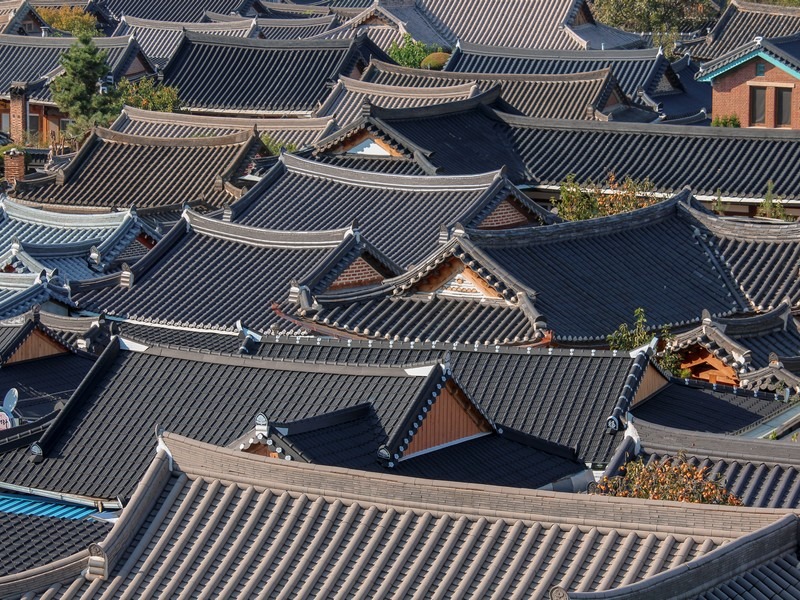
The History of Jeonju Hanok Village
It’s believed that Jeonju was originally founded as a market town in the Baekje Kingdom around 57 BCE. The city was conquered by the Silla Kingdom in 660CE but eventually the peasants revolted and Jeonju became the headquarters of one of the most powerful rebel leaders of the time.
Eventually, Jeonju became the capital of the Hubaekje Kingdom or the Later Baekje Kingdom which was around from 892 to 936. Throughout history, Jeonju was taken, revolted, taken, and flourished multiple times.

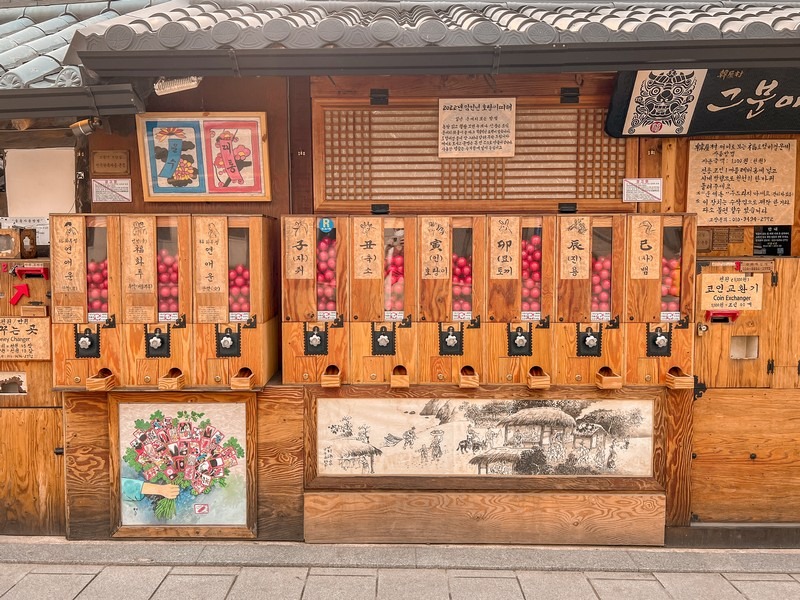
During the Joseon Dynasty, Jeonju was seen as the spiritual capital of the kingdom as Jeonju was considered their ancestral home. The Hanok Village, which was originally surrounded by a wall that was later destroyed as the city was expanding.
Supposedly, the reason why the village is so built up now is because of the Korean protests that occurred with the Japanese moving in after Korea was annexed in 1910. Today, the Jeonju Hanok Village is home to more than 700 Hanoks that are a mix of residential and businesses.
Where To Stay in Jeonju Hanok Village
Laon Hanok Gguljam
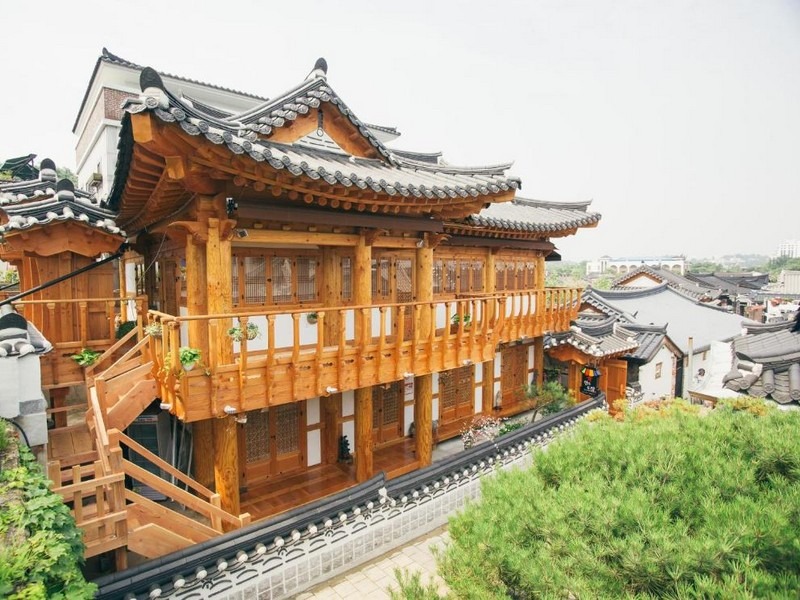
The great thing about the Jeonju Hanok Village is that you can stay in beautiful Hanok houses and really feel the tradition and culture of the town when you visit. The Laon Hanok Gguljam is near the Jeonju Fan Culture Center and is updated so rooms include a private bathroom with shower and has air conditioning. It’s comfortable but note that you will be sleeping on the floor so be prepared. If you’ve never tried, then give it a go. It might not be as bad as you think.
You can book a stay at Laon Hanok Gguljam on Booking.com or on Agoda.com
Jeongga Hanok
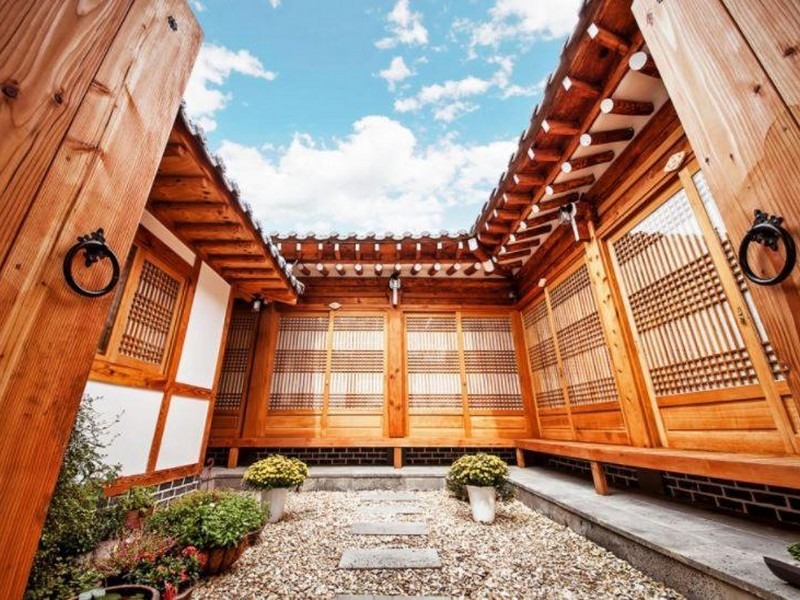
Another great traditional stay option is The Jeongga, or Jeongga Hanok. The property is well taken care of and has a very friendly owner that can even recommend things to see and do in the area if you didn’t get enough information from this substantial guide to Jeonju Hanok Village. The Jeongga also has laundry service if necessary, and has business facilities including a fax machine and photocopying if you’ve got some remote work to get done.
You can book a stay at Jeongga Hanok on Booking.com or on Agoda.com
Lahan Hotel Jeonju
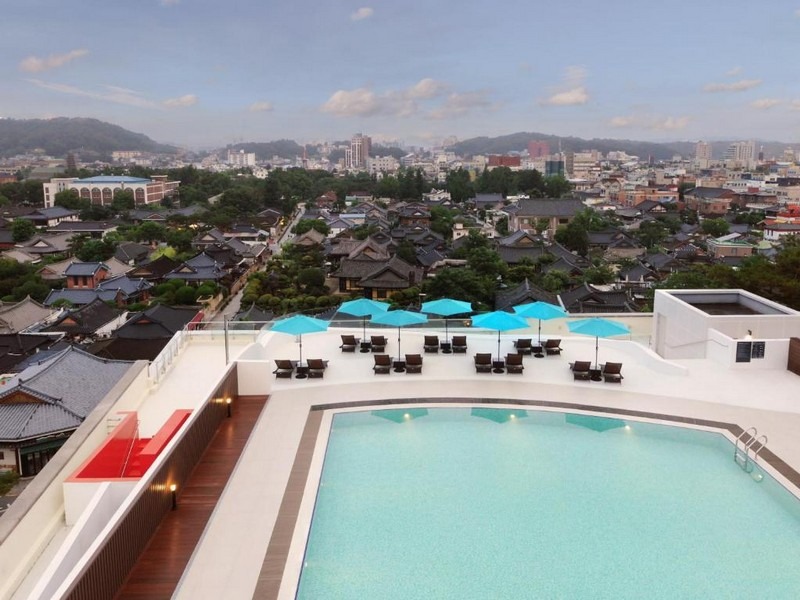
Maybe you don’t want an extremely traditional stay in the Jeonju Hanok Village but you still want to stay there? Not a problem. The last time we visited, we stayed in the Lahan Hotel Jeonju which also has a pool for a perfect summer addition to time in Jeonju. The hotel has all of the updated amenities you could want for comfort and you can step right out the back door into the Hanok village for the cultural and traditional fun. It’s the best of both worlds.
You can book a stay at Lahan Hotel Jeonju on Booking.com or on Agoda.com
What To Do
There are a lot of different things you can do while you’re in the Jeonju Hanok Village. I recommend looking and thinking carefully about what you want to actually do besides just eating your way through the village. You’ll need something to do between bites.

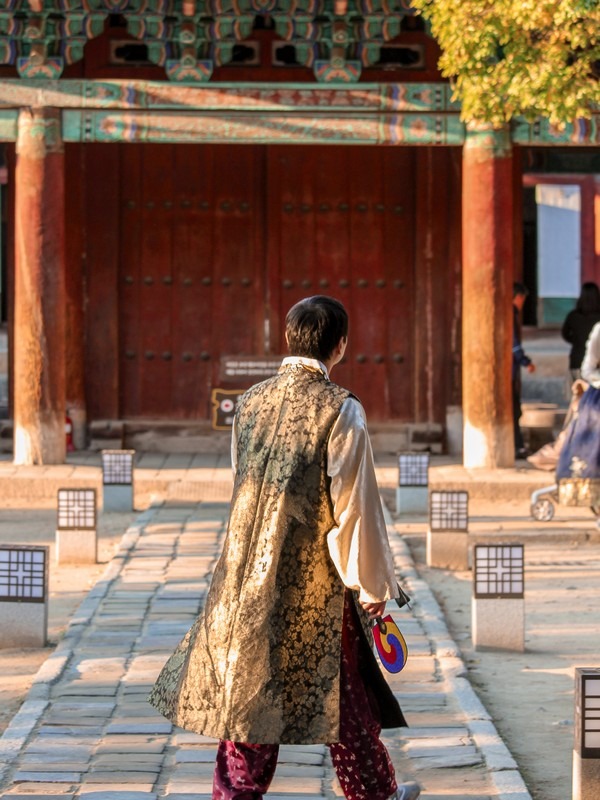
Rent Hanboks
Something many try when they venture to a Hanok village in Korea is trying on Hanboks and strolling around traditional village. Hanboks are traditional Korean clothing and their origin can be traced back to The Three Kingdom Period of Korea. Though, the ones you commonly see today are the style from the Joseon Dynasty.
There are a variety of styles and colors of dress to wear and wearing them in the traditional village make for just beautiful photos after your trip too. It’s not even that expensive to rent a Hanbok. It’s a surprisingly budget-friendly thing to do. The typical price is W8,000 (per person) for an hour and a half or so.
- Rent A Hanbok: Use Klook to get a discount on rental at Hanboknam Store in the Jeonju Hanok Village. Hanboknam have just gorgeous Hanboks in a variety of sizes too.
Create Your Own Jeonju Hanji Fan
The fan is the most representative craft of Jeonju and is made with Jeonju Hanji or Korean traditional paper made from the mulberry tree. Visit the Jeonju Fan Culture Center to see fan exhibitions and buy a variety of fans there if they intrigue you. You can also join an experience to make your own fan including a Dungeon, a round fan, a Jeopseon, a folding fan, or a Hapjukseon, a fan with spokes made of double slips of bamboo. This is also a great, lightweight, and easy to carry souvenir to take home with you.
- Book your experience: You can pre-book this experience on Airbnb.com
- Fee: $8.00
- Website: fanmuseum.co.kr

Join A FREE Walking Tour

The tourism organization promoting the Jeonju Hanok Village offers 7 different FREE walking tours. Yes, you heard that right. They’re free. You just pay the admission fees to get into the shrines, etc. Information tours like this are really invaluable. Whether it’s your first time, or your fifth time some place, you can always get something out of a tour with a knowledgeable guide in my opinion. For example, when I visited on a tour, I got to meet the Imperial Highness King Yi Seok, the living descendant from the Joseon Dynasty royal family. It was literally one of the coolest things I’ve ever done in Korea and all because I joined a tour. Who knows what you can learn.
- Hours: Each tour course runs at different times but run every day between 10:00am and 3:00pm so it’s a good activity to start the day with to get your bearings in the area.
- Duration: Most tours take just an hour.
- Learn More: http://hanok.jeonju.go.kr/contents/en_tour
Enjoy a traditional tea ceremony
One aspect of Hanok villages that you don’t want to sleep on is none other than a traditional tea ceremony. Tea ceremonies are beautiful and you can learn a lot about the Korean culture through them while sipping on delicious tea of course. Learn more about Korean tea and what to drink here.
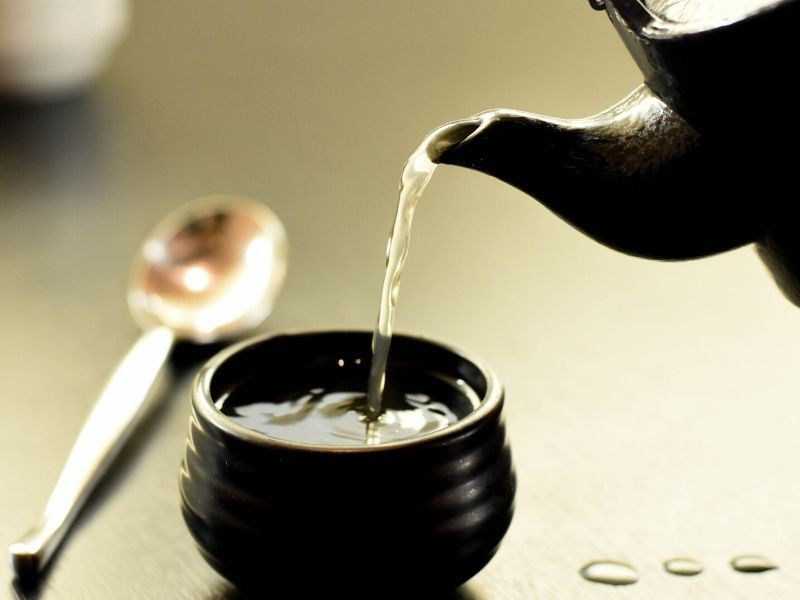
Recommended tea houses in Jeonju Hanok Village:
Gyodongdawon (교동다원)
A popular tea house for tourists, sit on the floor near the windows in Gyodongdawon and take in the beautiful courtyards. It’s a bit of a well known hidden oasis. Receive your tea and an English introduction and then stay, sip, and stay some more.
- Address: 65-5 Eunhaeng-ro, Wansan-gu, Jeonju-si, Jeollabuk-do (전주시 완산구 운행로 65-5)
- Hours: Monday, Wednesdays -Fridays, Sundays: 11:00am ~ 8:00pm; Saturdays:11:00am ~ 9:00pm
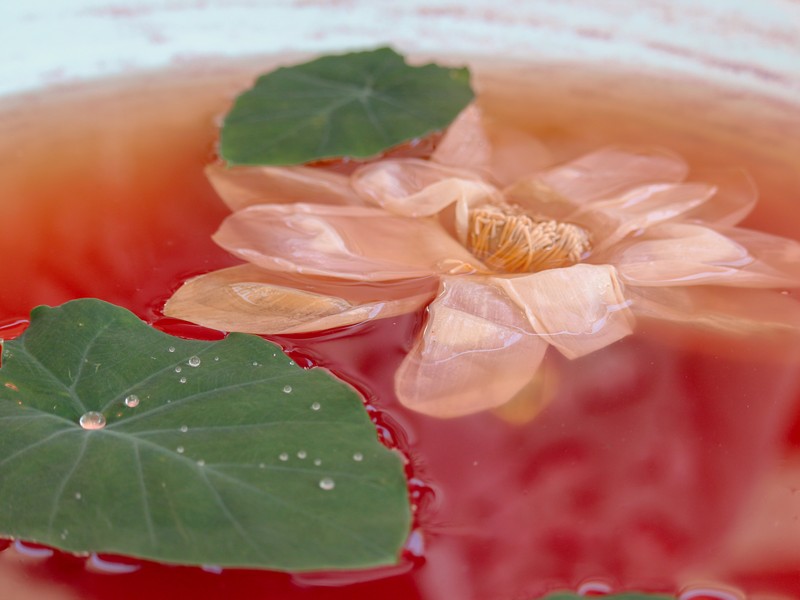
Dahwawon
Step into this picturesque Hanok tea house with a range of teas on the menu from flower teas, including plum flower tea to chrysanthemum tea among other great options though the flower teas always make for a beautiful picture. Receive your ceremonial tea kit on a tray and watch as the flowers bloom when the water is poured over them.
- Address: 13 Choimyungheegil, Wansangu, Jeonju (전주 완산구 최명희길 13)
- Days: Monday ~ Sunday
- Hours: 10:00am ~ 7:00pm
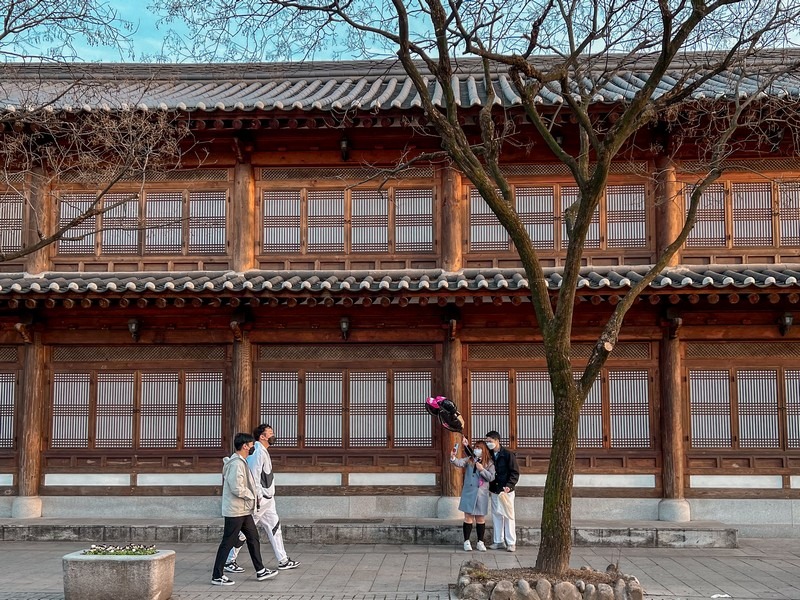
Make A Traditional Name Stamp
Did you know that in Korea, Koreans don’t put a signature on contracts or forms, but instead use a unique stamp that they registered with the government? These name stamps are interesting and a unique souvenir that you could easily take home with you as they’re small and lightweight but beautiful and will be unique to you!
- Book your experience: You can pre-book this experience to make a name stamp on Airbnb.com
- Fee: $24 per person
- Duration: Takes about 2 hours
- Notes: Best for guests 13 years or older.
Make Moju
Have you heard of Moju before? I would guess not. It’s very delicious though. Moju is a slightly thick Korean drink with a fairly low alcohol content based on makgeolli, or fermented rice, but then brewed with herbs and spices that include cinnamon, ginger, jujube, ginseng, and licorice root. It’s a comforting drink and sure to soothe your soul after a day of walking around Jeonju Hanok Village.
- Book your experience: You can book the Moju Making Experience on Airbnb.com.
- Fee: $20 per person
- Notes: Guests must be 20 years or older for this experience.

Walk Along the Hanok Village Route (한옥마을 울레길)
Omokdae is where you want to go to find one of the best vantage points in the village for a nice view out over the Hanok rooftops. It’s also the place where Yi Seonggye celebrated a victory against the Japanese in 1380. You are granted a bird’s eye view of the whole village. It is a bit of a steep walk to arrive on top of the miniature mountain, but the view is worth the walk. This is also a good way to digest that delicious food you had and get ready for another meal.
- Address: 55 Girin-daero, Wansan-gu Jeonju-si, Jeollabuk-do (전라북도 전주시 완산구 기린대로 55)
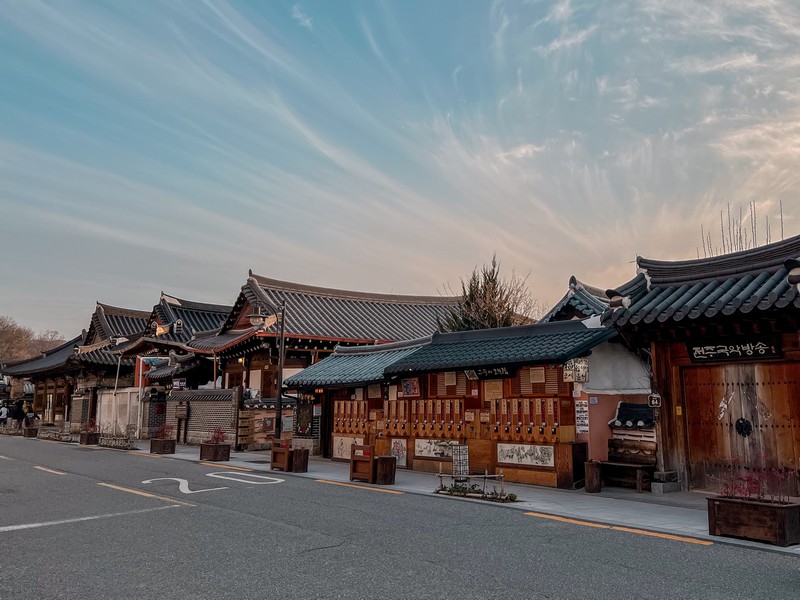
Rent Bikes To See The Area
You can walk or ride your way through the Jeonju Hanok Village. There are three bike rental locations within the Hanok Village which will make your time in the area active and fun.
- Rental Locations:
- Hanok Village (Chimyeongjasan) Rental: 92 Baramssoeneun-gil, Wansan-gu (전라북도 전주시 완산구 바람쐬는길 92)
- Hanok Village (Omokdae) Rental: 7-9 Pungnam-dong 3(sam)-ga, Wansan-gu (전라북도 전주시 완산구 풍남동3가 7-9)
- Hanok Village (Hyanggyo) Rental: Riverside in front of 30-1, Jeonjucheondong-ro, Wansan-gu (전라북도 전주시 완산구 전주천동로 30-1)
- Days: Tuesdays ~ Sundays (Closed Chuseok, and throughout January and February)
- Hours: March, November, December: 10:00am ~ 5:00pm; June – August: 9:00am ~ 7:00pm; April, May, September, October: 9:00am ~ 6:00pm
- Fee: W1,000 per use
Take an etiquette class
At the Jeonju Traditional Culture Training Institute, you can learn Korean etiquette while staying in old houses. This is a great place to go to experience Korean-style cultural training and education. The training lasts between a day and two days depending on age so get ready to really jump into Korean culture here.
- Address:119-6, Hyanggyo-gil, Wansan-gu, Jeonju-si (전주시 완산구 향교길 119-6)
- Website: http://www.dongheon.or.kr
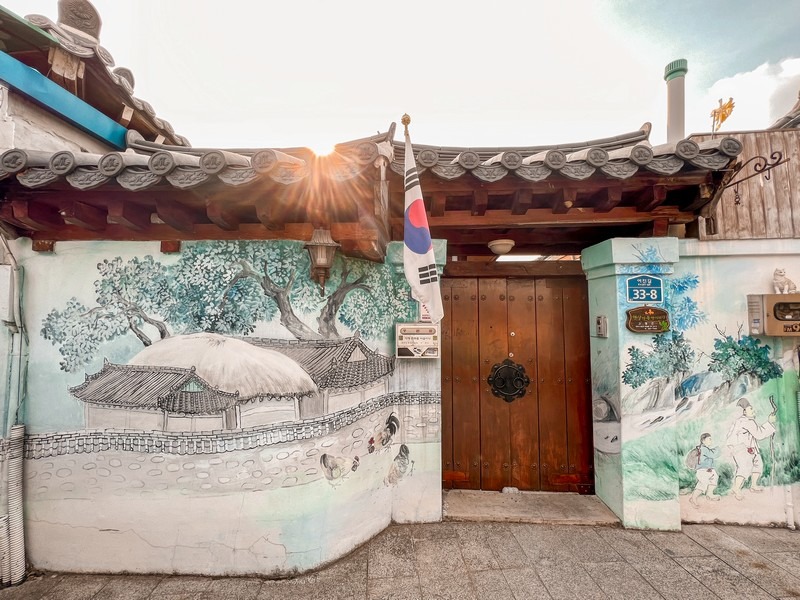
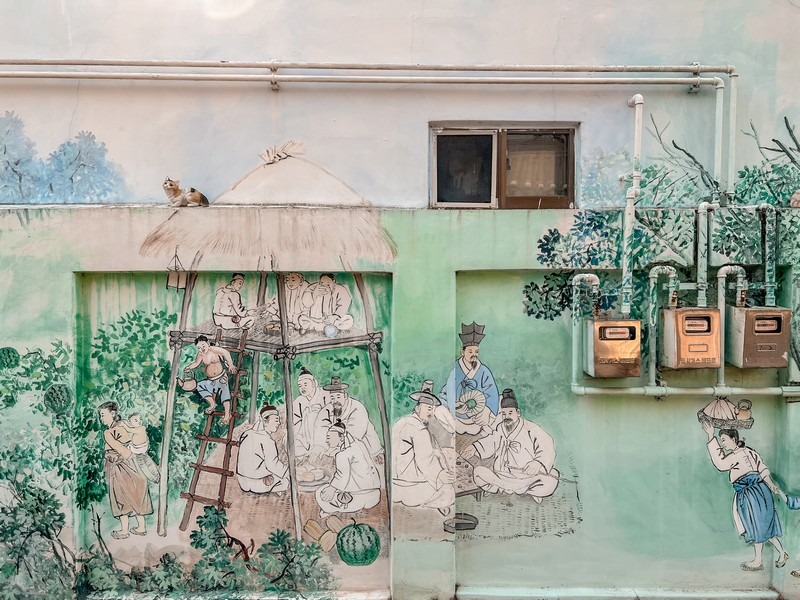
Find Some Murals
While there is a mural village just up the road and this is not that, you would be surprised by what you can find down the little alleyways of the Jeonju Hanok Village. Don’t stick to the main roads of the village but weave in and out of the alleyways and see what you can find. Some of the alleys are lined with the more traditional stone walls but some have hidden gems like these murals.
What To See
There is plenty to see from the beautiful slate-tiled rooftops of the quaint and traditional Hanoks to more. Plan ahead so you know what to see when you visit Jeonju Hanok Village.
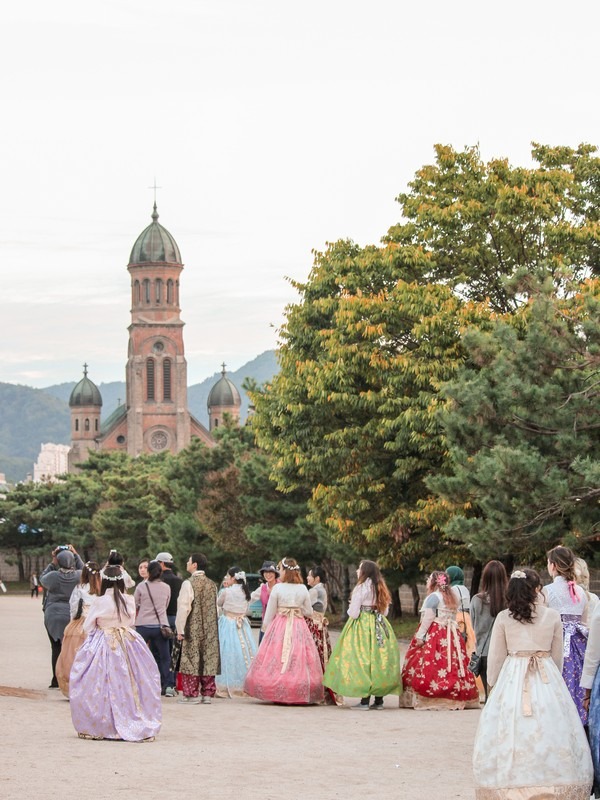

Jeondong Cathedral (전주 전동성당)
The Jeondong Church of Francis Xavier was built between 1908 and 1914 by Victor Louis Poisnel. It’s a historic monument and belongs to the Diocese of Jeonju. If you ever wanted to see a legendary cathedral on your journey through the village, make sure to stop by.
- Address: 51 Taejo-ro, Wansan-gu, Jeonju-si, Jeollabuk-do (전라북도 전주시 완산구 태조로 51)
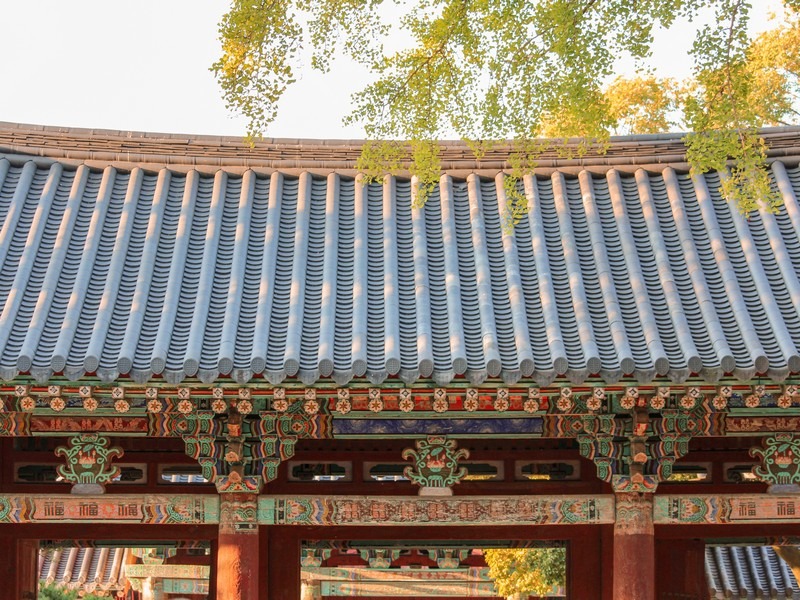
Gyeonggijeon Shrine (경히전)
Gyeonggijeon Shrine was erected in 1410 and possesses the portrait of King Tae-jo, the founder of the Joseon dynasty. It’s a very sturdy creation, getting partially destroyed during the Imjin War and restored in 1614. Repairs to the building were done in 1872 when a new reproduction of King Taejo’s protrait was enshrined there.
Visit the pavilion inside and walk amongst the beautiful buildings. You can look inside to see the carvings and corridors. It’s a beautiful area right in the middle of the Hanok Village and really you have to see it at least once.
- Address: 44 Taejo-ro, Wansan-gu, Jeonju-si, Jeollabuk-do (전라북도 전주시 완산구 태조로 44)
- Days: Closed on Mondays and January first.
- Hours: March – October 9:00am ~ 7:00pm; November – February 9:00am ~ 6:00pm
- Admission: Adults: W3,000; Teenagers: W2,000; Children W1,000
- Special Note: Free admission on New Year’s Day, day of Seollal (Lunar New Year’s Day) & Chuseok (Korean Thanksgiving Day), Independence Movement Day (March 1), & Liberation Day (August 15)
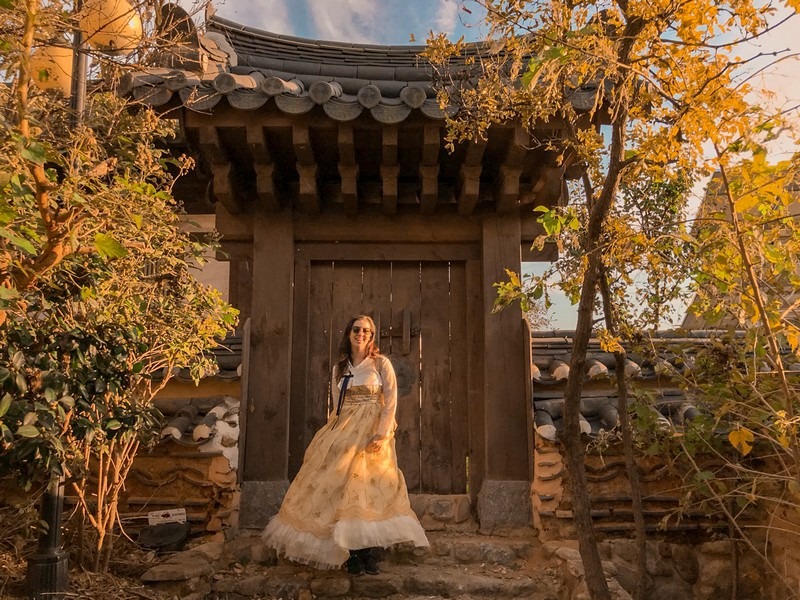
Jeonju Hyanggyo
Jeonju Hyanggyo is a wonderful shrine to visit in Jeonju, created sometime during the 15th century. It also used to be a school. The school was moved in the early 1600s due to the location’s destruction during the Second Japanese Invasion in 1592. What makes this location stand out is that it’s placed on level ground, something very unconventional from typical shrines. There are a total of 99 rooms there. Talk about a lot of space!
- Address: 139 Hyanggyo-gil, Wansan-gu, Jeonju-si, Jeollabuk-do (전라북도 전주시 완산구 향교길 139)
- Hours: 9:00am ~ 6:00pm
What To Eat
Did you know Jeonju was named an UNESCO City of Gastronomy in 2012? Once you’ve seen all there is to see, meandered down the small alleys lined with Hanoks, now it’s time to eat! You’re in luck because Jeonju is known for goooooood food.
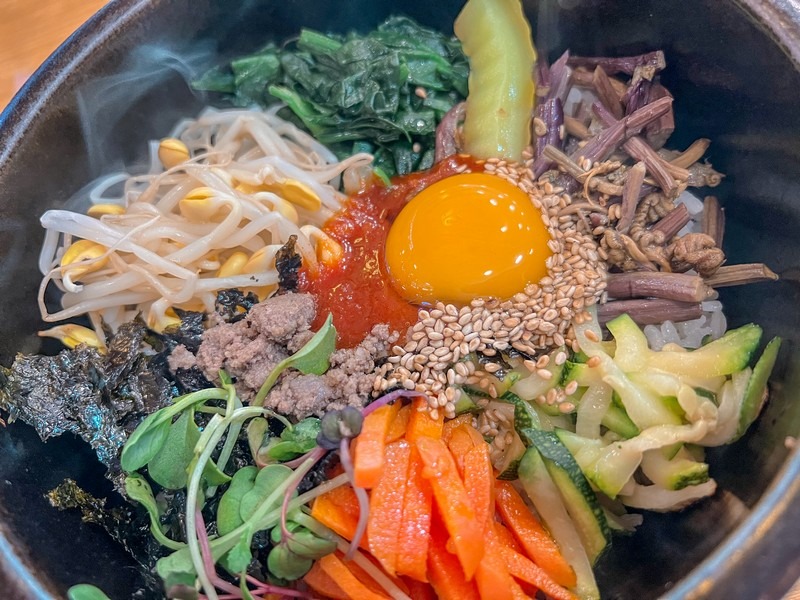
Bibimbap (비빔밥)
Bibimbap is one of the first meals most people have when it comes to Korean food. But, if you’ve only had the airplane version, then try it again. It gets even better. Translated as “mixed rice”, bibimbap is a dish usually served with warm rice and sautéed/seasoned vegetables on top with kimchi, soy sauce, or doenjang (fermented soybean paste). A raw or fried egg, as well as meat, usually accompanies the dish. It looks beautiful when served with all of the vegetables separated on top of the rice, but make sure you stir it all up before eating.
Here are some of the types of bibimbap you can try while you are in Jeonju:
- Jeonju bibimbap: Your typical bibimbap created in Nambu Market. Has a great taste by boxing in raw egg yolk.
- Yukhoe Bibimbap: As a beef tartare type, it has a distinct taste and unique texture that melts in the mouth. Haven’t had beef tartare, or yukhoe, in Korea yet? Now is the time.
- Dolsot Bibimbap: This is the hot pot version of bibimbap developed in Jeonju back in the 60s. It has a very appealing crispy texture from the hot stone pot that is used to make it as the rice gets a little crispy on the bottom. Be sure to stir this one up and listen to it sizzle when it arrives.
Your bibimbap will also likely come with a side of mung bean sprout jelly, a local delicacy…

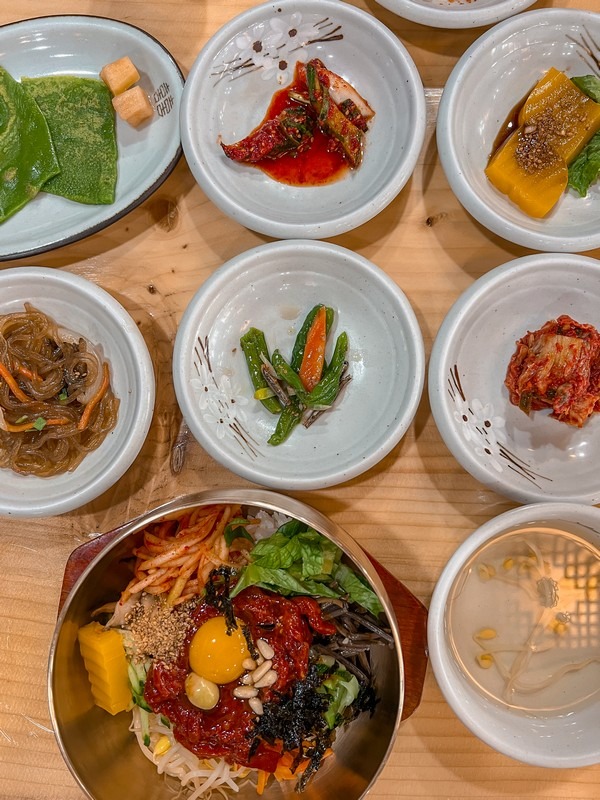
Recommended places to go:
Gajok Hegwan (기족회관)
Led by the master Kim Nyeonim, the Jeonju Food Master No.1, the bibimbap here has a special bibimjang sauce developed by master Kim Nyeonim. You may have seen her face on TV as she’s a famous chef in the country. The sauce isn’t too spicy or salty but a good mix with the rice and vegetables. She is very strict about what food materials she chooses so you can be assured that you’re getting a high-quality product.
- Address: 17 Jeollagamyeong 5-gil, Wansan-gu, Jeonju-si (전주시 완산구 전라감영 5길 17)
Han Kook Jib
Included in the Michelin Guide, Han Kook Jib has the longest history in Jeonju with three generations over 65 years of history. The highlight is the house-made hwangpomuk, or mung bean jelly dyed with gardenia. The delicate texture of the jelly perfectly relieves the spicy taste of the bibimbap.
- Address: 119 Eojin-gil, Wansan-gu, Jeonju-si (전주시 완산구 어진길 119)
Flower Shop (꽃담집)
This is where I went on this last trip to Jeonju. The bibimbap was beautifully presented. You have probably heard of build-a-bear, well here’s build-a-bibimbap. If you aren’t a fan of a lot of spice, stay away from things like kimchi. Delicious spot in the middle of the Hanok village.
- Address: 38 Eunhaeng-ro, Wansan-gu, Jeonju-si, Jeollabuk-do (전라북도 전주시 완산구 은행로 38)
Pungnamjeong (풍남정)
This is another place for fine Korean cuisine. There are three types of bibimbap here. Ju is the traditional kind with tasty veggies and rice. The second one is dolsot bibimbap, the hotter version. The last one is beef tartare bibimbap. This one packs a stronger punch than the others.
- Address: 52 Taejo-ro Wansan-gu Jeonju-si, Jeollabuk-do (전북 전주시 완산구 태조로 52)
Jongno Hoegwan (종로회관)
Tteok galbi and bibimbap are two of the items you are going to want to try at this establishment. They are also known for their spicy sauce and side dishes. If you want something else, tteok galbi is also worth trying. This restaurant was featured on “1 Night, 2 Days”, a Korean variety show, so they have somewhat of a fanbase of visitors.
- Address: 60-1, Jeon-dong, Wansan-gu, Jeonju, Jeollabuk-do South Korea (전라북도 전주시 완산구 전동 60-1)
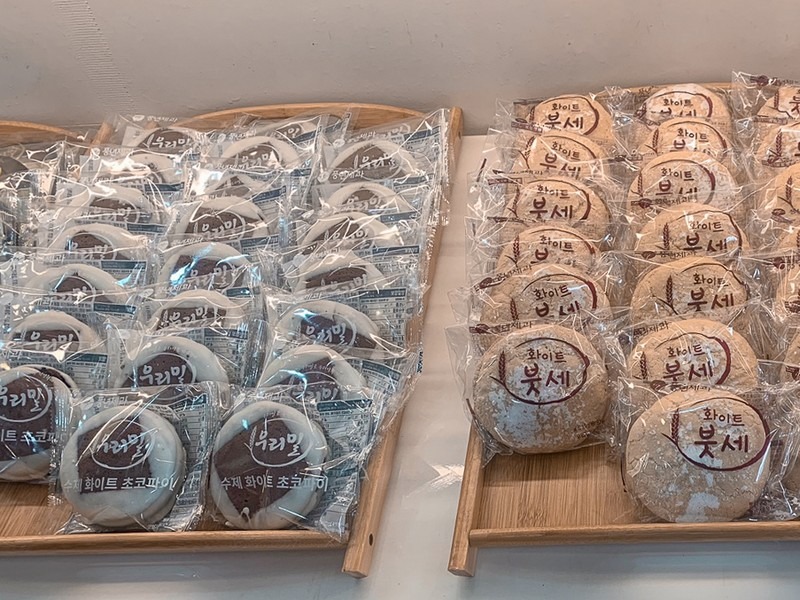
Choco Pie
Maybe an unexpected sweet treat in the Hanok Village, crafted from cake, marshmallows, and chocolate as a base point, the choco-pie is a unique and delicious delicacy that you don’t want to miss out on here. These moon pie-like cookies have an outer layer and an inner layer—just like a sandwich and they hit the spot any time of the day.
Recommended places to go:
Poongnyun Confectionery Woori Wheat Bread (풍년제과우리밀빵)

There’s a wide variety from more chocolate to vanilla and other options in between like almond and peanut butter. You can get five different cookies for only W7,000. The juicy insides that you bite into are like biting into a peanut butter & jelly sandwich and are simply divine and very relaxing. Speaking of jelly, many of the interiors of the pies have that packed in (or a chocolate version that is just as fluid as jelly), so don’t be shy and try one out!
You can grab a larger case of one type or multiple mixed together for around W9,000 ~ W10,000 depending on what you get. There are even larger assortments that cost around W35,000 that you can take back home to your loved ones or share with a larger group.
- Address: 42 Oejin-gil, Wansan-gu, Jeonju-si, Jeollabuk-do (전북 전주시 완산구 어진길 42)
Jeon Ju Choco Pie (수제전주초코파이)
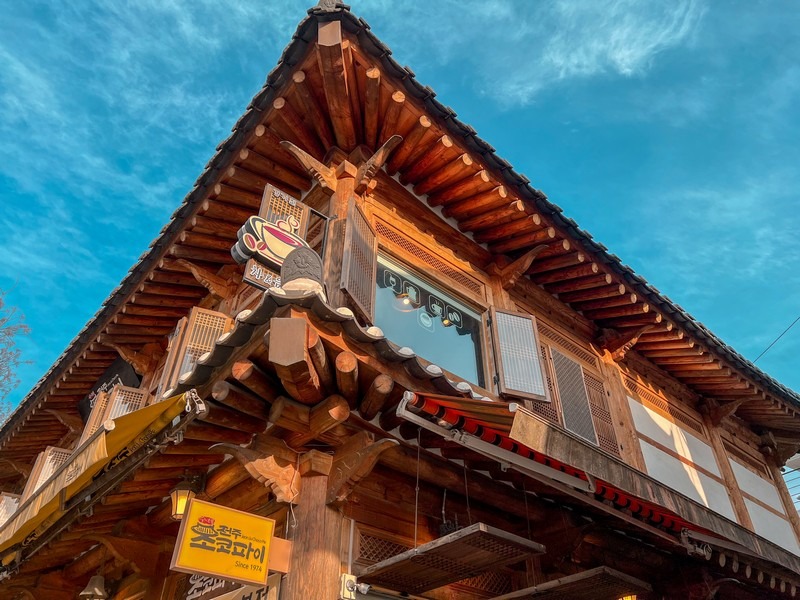
Established in 1974, on this last trip to Jeonju, we decided to try this version of the infamous choco pie. Jeon Ju Choco Pie has the simple and approachable chocolate version, but you can also try others like a banana choco pie, blueberry choco pie, pumpkin choco pie, and more. The blueberry choco pie was surprisingly delicious if you ask us.
- Address: 35 Taejo-ro Wansan-gu, Jeonju-si, Jeollabuk-do (전북 전주시 완산구 태조로 35)
What to see nearby
It’s always good to have a few extra things tagged and ready to go should you or your group have some extra time to meander. Here are a few things in the area that you can also have fun doing without going too far.
Jeonju Hanok Rail Bike (한옥레일바이크)
Near the Jeonju Hanok Village, if you have some time and want to do something a little active and fun, hop on a rail bike to see the more natural surroundings of Jeonju. Take the tracks through a colorfully lit up tunnel enjoy some fun scenery along the 3.2 kilometer distance of the tracks.
- Book Your Ride: Book tickets in advance via Trazy to ensure you can get on. They can sell out during high season.
- Address: 420 Dongbu-daero, Uadong 1-ga, Deokjin-gu, Jeonju-si, Jeollabuk-do
- Duration: 50 minutes (25 minutes each way, out and back)
Jaman Mural Village (자만벽화마을)
What feels like a location straight out of a cartoon is none other than the tranquil lands of Jaman Mural Village which sits just across and up the road from the Hanok Village. It’s very picturesque and peaceful at every turn of the small winding buildings and uphill walkways. Both western and eastern art can be seen there from classic anime movies like Spirited Away and My Neighbor Totoro to western giants like The Beatles and even Adventure Time.
- Address: 50-79 Gyo-dong, Wansan-gu, Jeonju-si, Jeollabuk-do (전라북도 전주시 완산구 교동 50-79)
Walk along the Jeonjuchun riverside
Take a stroll down the Jeonjuchun Riverside which is at the southern and western sides of the village for a brief respite from the bustling town. It’s a great way to walk on your way to a local market. The air is nice, there are bridges for shade, and you can even spot some local wildlife like cranes if you look hard enough. The area is very picturesque and a great area to enjoy the scenery and lay low or take a quieter break from the touristy Jeonju Hanok Village.
Jeonju Hanok Village is an ideal daytrip or weekend trip away in Korea. You should go at least once, but you could go numerous times and find plenty to do.
Did you like this post? Pin iT!
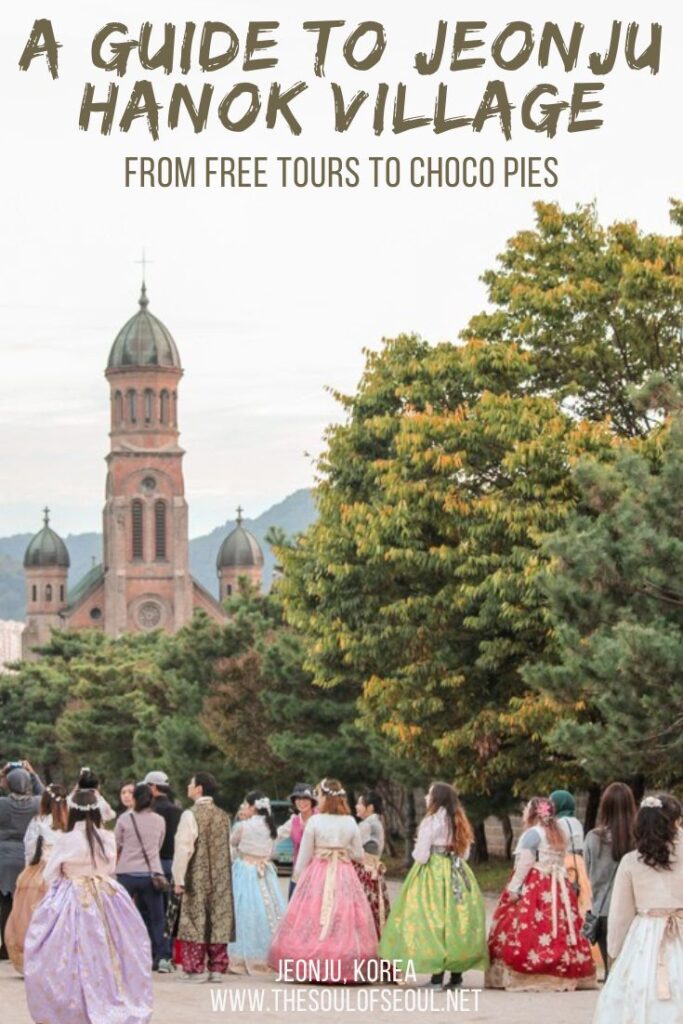
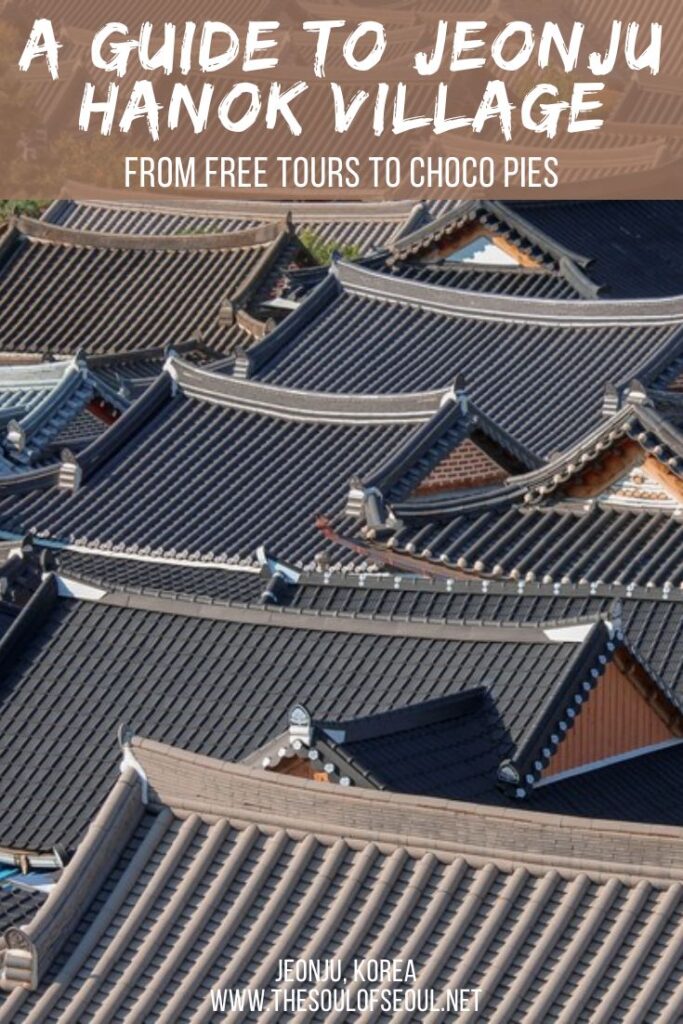


8 Comments
Lulu
I want to do everything listed here! How many days do you suggest? Also, I want to do day trips to the bamboo forest that you blogged about. Any other places you suggest to visit nearby?
Hallie Bradley
Hi Lulu, Jeonju is a great weekend trip from Seoul. The Sansok Lighthouse is nearby. It’s an arts and culture space. You can find more information here -> https://thesoulofseoul.net/sansok-lighthouse-jeonju/
Ling
Hi Hallie
Wish you’re well
Hope you can advise us on train transit time require.
We’re traveling on ITX train
Chuncheon to Yongsan
0925 arrival 1037
Transit KTX train from Yongsan to Jeonju
1052 arrival 1236
Looking at the train transit only 15mins is it enough? Yongsan seems quite a big train station, my worry is when we arrive Yongsan, the search for the right train
Hallie Bradley
Hi Ling, Generally I would say if you have a good spotter, as in someone that is quick to read signs and move, you should be fine. I’m like that. If you will have a lot of things to carry you might need a bit more time. If I’m picturing the station inside correctly in my head, you’ll want to go up from the platform one level to transfer to a different platform for ITX, but that’s it. Otherwise, you’d go up one floor to walk through the main station area and then have to go down on the other side. There’s only two areas to go up and down though so like I said, if you’ve got a person in the group who is quick to navigate, you should be fine.
Kim Lim
Hi Hallie,
Thank you for your blog, it has been really informative. Could i ask about the free walking tour (Hanok Village Alley way) in Jeonju, how do you join this type of tour? Do you need to reserve a slot or just rock up to the meeting spot to join the tour?
Thank you
Hallie Bradley
If you check out the link under the free tour heading above, it seems to say if there’s a group you need to make a reservation otherwise you can just show up to the meeting point. “Individuals with less than 20 people can come to the meeting point after checking the desired course time on the timetable without making a separate reservation.” You can Google translate that page to see the meeting points or stop into the tourism booth when you arrive to ask them just to be sure. Have a good time!
ying
Hi Hallie,
May I ask for some advice?
My flight arrives Incheon at 745am and I’m thinking of 2 different routes for travelling.
Option1
Day 1: Jeonju. Do you think we can make it to catch the 9.45am KTX departing Seoul Station to Jeonju. Or should we take a later KTX? eg 10.55am or 1235pm?
Day 2: Jeonju
Day 3: KTX to Suncheon
Day 4-5: Suncheon
Day 6: Bus to Busan
Day 7-9: Busan
Day 10: Fly to Jeju
Day 11-12: Jeju
Day 13: Fly to Seoul
Option2
Day1: Jeju. Catch the 1050am flight to Jeju. Otherwise the 1150am flight
Day 2-3: Jeju
Day 4: Fly to Yeosu then bus to Suncheon
Day 5-6: Suncheon
Day 7: Bus to Bunsan
Day 8-10: Busan
Day 11: KTX to Osong then train to Jeonju
Day 12: Jeonju
Day 13: KTX to Seoul
From Kakao map search, seems like Option 1 may require less travelling time? or perhaps both are the same?
Hallie Bradley
If you wanted to head to Jeonju on the train, I’d plan to take a later train. The good thing is that you don’t have to pre-purchase train tickets (unless you’re trying to travel over the Korean Thanksgiving or Lunar New Year holiday period.) You can usually get to the train station and just get tickets upon arrival since they hold some back from online purchase for walk-ups. Since you also have to take a PCR test at the airport, you should just give yourself a bit more time to get through immigration, customs, and then the PCR test before taking the subway into the city to the train station.
There would definitely be less hassle right at the beginning of your trip with transportation if you’re instead flying directly to Jeju. Just less trains and things to deal with. I suppose I’d go with option 2 myself and stick with planes for the first part of the trip. Either way, make sure you get your arrival PCR done at the airport so you don’t have to worry about that.